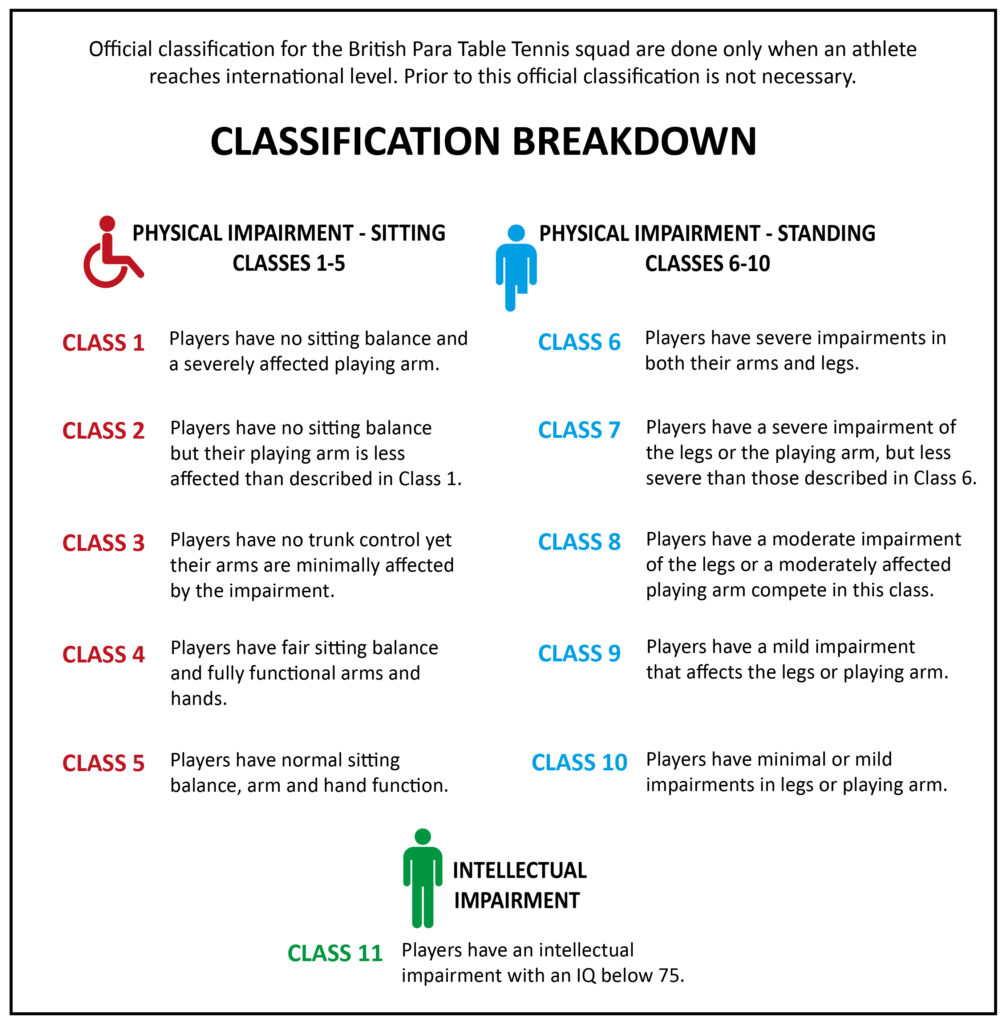Classifications and regulations
Guidelines for competition eligibility.
Para table tennis classifications
For an overview of para table tennis classifications, click on the image below.
Rules adaptations for players in wheelchairs
The ITTF laws of table tennis include several adaptations for players in wheelchairs, as detailed below and in the subsequent video:
The umpire may relax the requirements for a correct service if he or she is satisfied that compliance is prevented by a physical disability. This will always be done for Class 1 B C D A Page 16 and Class 2 players (refer Appendix H). The player’s international classification card contains a section indicating any physical limitations that the player may have affecting compliance with the requirements of a correct service e.g. where a player with a disability is either not able to straighten his or her palm or does not have a hand, the player may serve with a curved palm or toss the ball from his or her stump.
If the receiver is in a wheelchair due to a physical disability, the rally is a let if the ball comes to rest on the receiver’s court, or after touching the receiver’s court returns in the direction of the net, or, in singles, leaves the receiver’s court after touching it by either of the sidelines. This is because a player in a wheelchair, by definition, is restricted in the extent of his or her ability to stretch and a service returning towards the net or going out from the sidelines is regarded as unfair. The ball can cross the sideline after one or more bounces. However, in singles play and where the ball is travelling towards the side line, if the receiver strikes the ball before it crosses a sideline or takes a second bounce on his or her side of the playing surface, the service is considered good and no let is called.
If both players or pairs are in a wheelchair due to a physical disability and a player does not maintain a minimum contact with the seat or cushion(s), with the back of the thigh, when the ball is struck; or touches the table with either hand before striking the ball; or his or her opponent’s footrest or foot touches the floor during play, this is considered to be gaining an unfair advantage and the opponent is awarded a point. If a player is in a wheelchair due to a physical disability, he or she may only touch the table with his or her racket hand to restore balance, only after a shot has been played, provided the playing surface does not move. The player is not allowed to use the table as an extra support before striking the ball. Similarly the player may not use his or her free hand on the table as an extra support, or touch the playing surface at any time during the rally. In a doubles match this applies to both players.
If a player with a disability is unable to play temporarily due to the nature of his/her disability or condition, the referee may, after consulting a medical classifier or doctor at the competition, allow a medical recovery time of the shortest practical duration, but in no circumstances more than 10 minutes.
When a doubles pair comprises two players who are in wheelchairs due to a physical disability, the server first makes a service and the receiver makes a return, but thereafter either player of the disabled pair may make a return. However if any part of a player’s wheelchair protrudes beyond the imaginary extension of the centre line of the table, the umpire will award a point to the opposing pair. This also applies when a “mixed” pair (one standing and one wheelchair) are playing together. Either player may return the ball (after initial service and return), but each player has to remain in his or her own half of the court. No part of the player’s wheelchair can cross the imaginary extension of the centre line and the standing player cannot put a foot over this line either.
Transgender
There are some eligibility guidelines for transgender participants, as agreed by The International Olympic Committee (IOC) at the Consensus Meeting in November 2015. The guidelines can be downloaded below.


